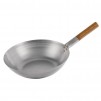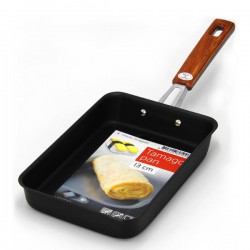Derfor har over 21.000 handlet her
Pots, pans and wok accessories
Wok - The Chinese multifunctional pot
You may have heard of a wok before, perhaps in connection with so-called "wok dishes." A wok is a deep, round pan that originates from China. A wok can be used for many things, ranging from stir-frying, steaming, deep-frying, poaching, boiling, braising and searing to stews, soups and toasting nuts.
The most characteristic feature of a wok is probably its rounded bottom, which gives it a bowl-like shape. This provides a large surface to work with, unlike the traditional pots we're used to at home. At the same time, a wok is typically made from materials that conduct heat well, so you can push the food around depending on how and how much it needs to be cooked.
In Western countries, where electric stoves are very common, the wok typically has a flat bottom so it can sit on the stovetop. In Asia, woks are often completely round-bottomed, allowing them to be placed directly on the flame and get even closer to the heat source. The extra curve also makes it easy to toss the food and to use a ladle to scoop everything out of the pan.
Steel wok pans
Today's wok pans are mostly made of steel, a relatively inexpensive material that provides both lightness and good heat distribution — two clear advantages. A wok is almost always in motion, whether you're stirring at the bottom or swinging it from side to side. That can be difficult with a cast-iron wok, which tends to weigh somewhat more.
The weight of the wok also depends on its thickness, and in this case a thin wok is preferable. A thin wok makes it easier for the wok to reach the desired temperature, while also being easy to handle. Temperature is important when it comes to preparing a lot of Asian food. For example, if you are going to make a stir fry (English: "stir-fry" — to fry quickly while stirring, typically in a wok) or want to try their hand at the bao technique, so it is incredibly important to have high temperatures. With the bao technique, a wok is heated until it is almost red-hot, and then meat, oil and spices are added while the wok is kept in constant motion. The focus here is on the natural flavour of the ingredients, which is why few spices are added. At the same time the heat is decisive, because if the wok isn't hot enough it takes too long to cook — and the food loses all its juices and strength.
Wok pot or wok pan?
A wok can be used both as a frying pan and as a pot, and often people will think that the placement of the handles is what matters. You can get a wok with a single handle like a frying pan, or with two handles opposite each other, as is often seen on larger pots. However, the handles don't make any decisive difference beyond personal preference. Because you often toss the food around in a wok, it can be an advantage to choose one that's easy to hold with one hand. That gives you full control of the wok while allowing you to maneuver a spoon or similar utensil with your other hand.

 EN
EN
 DA
DA
 ZH
ZH

















